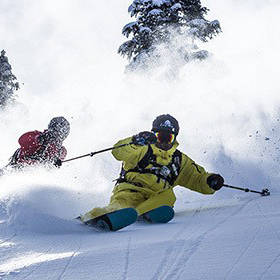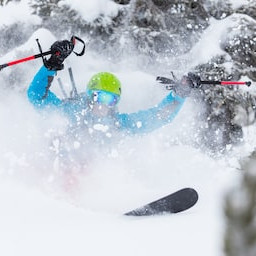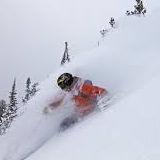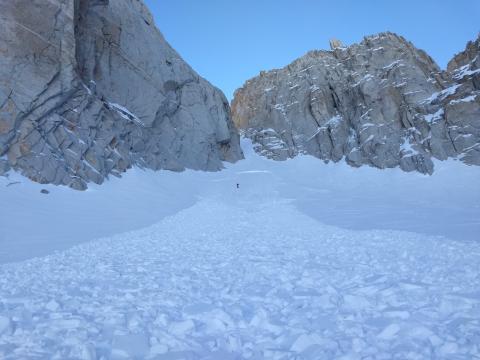
Report courtesy of Eastern Sierra Avalanche Center
It’s not easy to write this, but I’m just fortunate that I have the opportunity to do this and not currently buried under an avalanche, so I feel like I need to. I went out for a solo tour out of Twin Lakes yesterday. I started just before 9. I travel solo somewhat frequently in the backcountry (~100 times over the past 3 years) and am aware of the risk and what some might say stupidity of what that entails. I liked to think I made very conservative decisions when I was traveling alone. I planned to head up towards Matterhorn Peak/Doodad area and see how conditions looked before the next storm came in.
While skinning up, I was checking for instabilities. Some rain crust down low, that transitioned to soft unconsolidated snow over 8000’. Over 10,000 certainly more wind affected snow. No obvious signs of obvious instabilities were present. I dug a pit near treeline on a NE facing aspect around 9700’. I did find the buried weak layer under about 95cm of snow. ECTN8 @ 16cm, ECTN15 @ 35cm. No result down to weak layer. As I got up to the Doodad area, the more north-facing chute looked quite wind loaded and I decided I wouldn’t ski that line today, due to the risk of wind slab avalanche. I went to the more eastern facing chute, found good snow. No sign of wind slab or instability. Booted up and skied down and had some great turns. On the exit of the chute, I decided to traverse hard to the skiers right towards the base of the more N facing chute that I had just 90 min earlier said to myself I wouldn’t ski and even still I told myself I’d just see what the snow was like at the bottom.
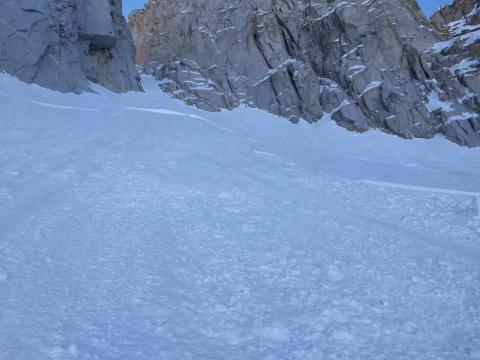
I found good snow at the bottom of the lookers right of this chute. I decided I’d start botting up to see if it stayed good. After a few minutes of booting, the snow changed to a 6-8” windslab. I didn’t feel good about this, so decided to transition and head back towards the car. I put my skis on and started the traverse back down towards my uphill skin track. I made the mistake of not going back the way I had just booted up.
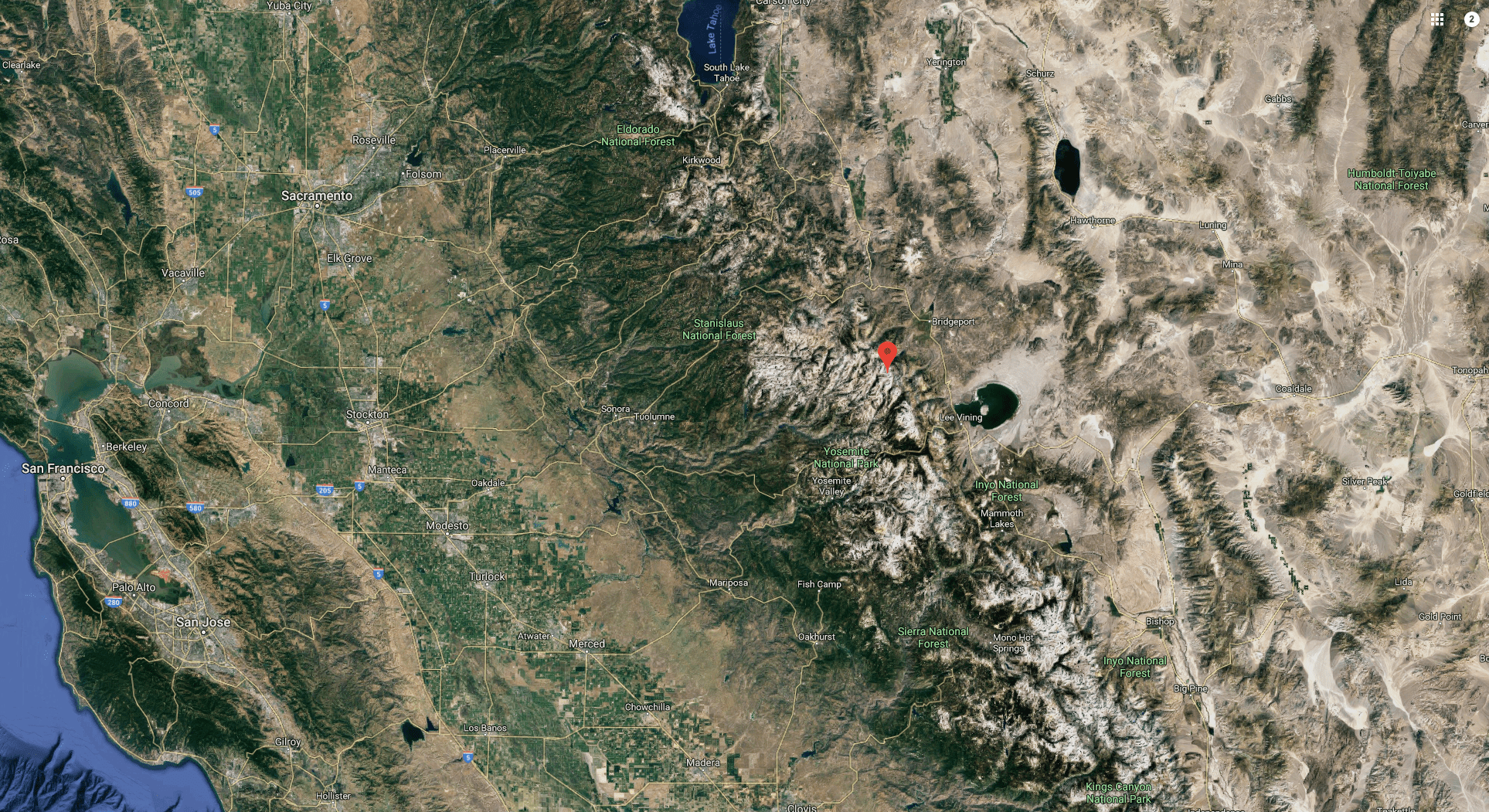
Maybe 2 seconds after starting the traverse, I felt the wind slab give out and looked first above and saw the crown fracture about 30’ above me and below me to see the slab breaking apart for about 100’ below. Unfortunately, I had just started the traverse and had no speed and knew immediately I had no chance of riding off the slab. The slide started slowly and I was able to reach down and release my skis. The first part of the slide I was able to stay on my back with feet downhill and on top. As it picked up speed I was flipped forward onto my belly and was submerged going headfirst and no longer could see any sky. I was trundled around and became very disoriented. As I felt the snow slowing down I tried to remember everything I had heard about what to do in an avalanche, but of course, leaving a pocket of air to breath doesn’t do much without a partner to rescue me. I tried to fight towards what I thought was the top. Somehow, just as the debris was coming to a stop I was flipped again with my feet downhill and on to my back and just happened to be right on top of the debris. I was able to self-extract within 20-30 seconds and had the biggest relief of my life. Avalanche was about 70-80′ wide, ran about 500′ and I was carried about 450′. Crown was 2-3 feet at tallest part. In the photos, I marked with a “T” where I triggered the slide and an “x” where I came to a stop.
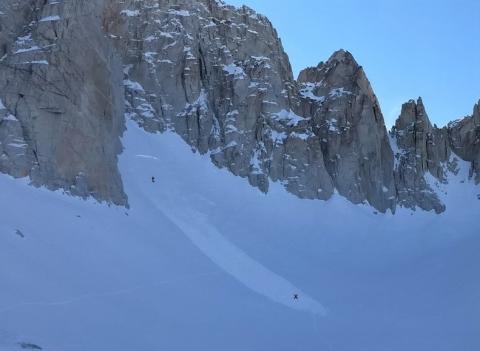
I found both my poles within 20 feet of me, one right on the surface and the other had just the top of the grip showing. No sign of my skis. I got out my shovel and started hiking up the debris in hopes of finding at least a single ski, but no luck. I was not excited about post-holing 5 miles back to the car, but considering the alternative that almost happened, I was happy to have that option.
As I started back, I saw one ski about 1000’ away down in the basin below the runout. I got to it and then saw the other one another few hundred feet beyond that. I was able to ski out. The only things that were lost were my glasses and any sense of confidence in my decision-making skills.
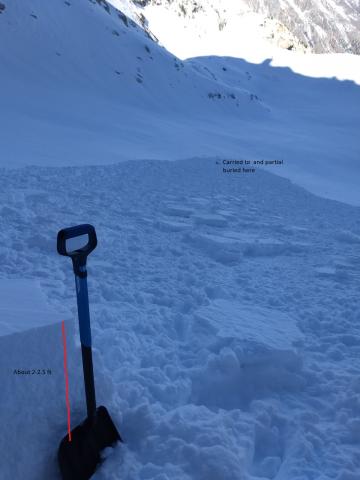
I’ve had about 24 hours to replay the day and the avalanche over and over again. Of course, the most obvious takeaway is that if I had a partner there, a rescue would have at least been possible if I was buried beyond the point of self-extraction. Second, if there is an area I have closed off to skiing for the day, as I did with the slope that slid, then I should not have allowed myself to just go and “check it out.” I made that initial conclusion for a reason. Without a partner, that conclusion was never vocalized beyond the confines of my head. Even after I had decided to boot up to check out the snow, I made the mistake of not retracing my steps when I determined it to be unsafe and instead cut across the slope in an effort to be efficient.
It will take more time to process what happened and how that will influence my backcountry skiing choices going forward. I do know that I won’t soon be forgetting that feeling that I had of being tumbled in an avalanche, knowing that no one would be able to come to rescue me. It’s just my hope that no one else experiences that feeling.
